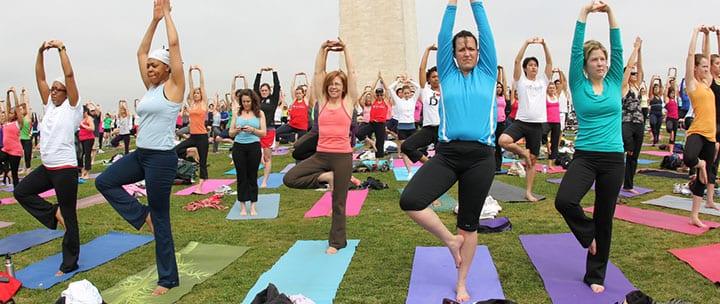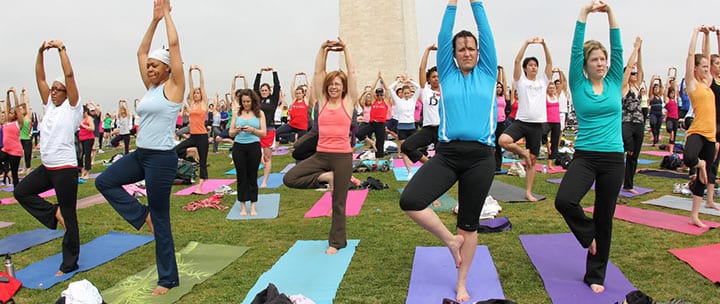Confused by all the different classes offered at your yoga studio? Here’s a quick guide to the different styles from San Diego teacher Tiffany V...
You may hear yogis (male practitioners) and yoginis (female practitioners) talking about the different types of yoga classes they attend and wonder what all these words mean: Hatha? Bikram? Ashtanga? Vinyasa? It’s all yoga! With its increased popularity, yoga has naturally transformed into several styles that each offers a spin on the ancient tradition. It is common for yogis to incorporate several of these styles into their practice for diversification.
Here is a guide to what’s presently being offered and practiced:
Hatha Yoga
This is the physical practice of the poses, which is what most in the West mean when they talk about yoga; “Hatha” is made up of two Sanskrit words: “ha” meaning “sun” and “tha” meaning “moon.” It’s designed to give the body a balance of the masculine aspects—active, hot, sun—and feminine aspects—receptive, cool, moon—through practice of a series of physical asanas (poses), controlled breathing techniques (pranayama), energy focus (chakras), mudras (hand gestures), and meditation (deep focus & clarity). All these aspects work together in balance to create harmony in the body, mind, and spirit.
Bikram Yoga
Bikram yoga is a set series of 26 poses performed on both sides of the body in a room traditionally set to 104 degrees with 40% humidity. It’s designed to purify the body through extensive sweating, and is taught in a disciplined style.
Vinyasa Yoga
Vinyasa yoga is a practice designed to match breath to movement, turning static postures into a dynamic flow where the inhales and exhales align with the physical motion of the body to determine the length of the transition between poses. It may also refer to a specific set of poses used for a transition in a sequence, such as the traditional chaturanga dandasana (high-to-low-plank, upward facing dog to downward facing dog series). The name translates as “Vi”- “in a special way” and “nyasa”- “to place.”
Ashtanga Yoga
Ashtanga yoga is a predetermined sequenced practice designed with a set series of poses. The goal is to maintain internal focus rather than advancing to more difficult postures, with a focus on the bandas (muscle locks) of the body. Practice starts with eight to 10 sun salutations followed by one of the six set asana sequences, then a back-bending sequence, concluding with a set of inverted asanas, referred to as the “finishing sequence.” Ashtanga always ends in savasana (corpse pose), a resting posture to allow the body to absorb the benefits of the practice.
Power Yoga
Power yoga is a challenging style focused on increasing endurance, strength, and flexibility by combining hatha, vinyasa, isometric holds, core strength, arm balance, and inversions. It’s designed to challenge the body and mind for a rigorous workout.
Yoga Sculpt
Yoga sculpt is a challenging, cardio style focused on toning every major muscle group of the body with use of weights and reps integrated into the practice. Strength-training exercises such as squats, lunges, and bicep and tricep curls are incorporated to build lean muscle mass for a total body workout.
Acroyoga
Acroyoga is a practice that combines aspects of yoga and acrobatics to build strength, flexibility, trust, and teamwork between partners. There are three roles in acroyoga: the base who lies flat on the ground with their entire torso and back pressed down with arms and legs extended above them for “bone-stacked” support of the flyer, who is supported above ground by the base’s hands and feet to reach dynamic postures. The interaction between base and flyer is always accompanied by a spotter who keeps focused attention on both the base and flyer to ensure the flyer lands safely.
Aerial Yoga
Aerial yoga is practiced suspended in a “U”-line silk swing, and focuses on integrating traditional yoga poses with the use of fabric support for stretching and conditioning. It involves inversions assisted by gravity, and a great deal of time is spent upside down with a focus on the breath to sustain the poses.
Yin/Restorative Yoga
This is a gentle, restorative form of yoga designed to stretch passively into the fascia, ligaments, and tendons of the body. Poses are held for longer periods of time in a very slow, meditative environment, and are usually performed with props (blocks, blankets, bolsters) to assist with comfort in the extended hold.
Yinki Yoga
This is yin/restorative yoga combined with reiki (hands-on energy healing). This style usually begins with breath work and meditation to center, and is taught by a yoga instructor who is also a Certified Reiki Practioner. Healing is offered throughout class with light touches that infuse universal energy into the body to assist in releasing blockage in the energy channels for a soothing experience designed to relieve tension and stress.
Prenatal Yoga
Prenatal yoga is designed to open up the body to make space for growing mothers while strengthening the spine and lower back. It prepares expectant mothers for childbirth by opening and stretching the hips, pelvis, and legs, and is usually paired with breathing exercises and meditation to create a soothing environment for mom and baby to connect.
When trying to decide which class may be right for you, consider your overall goals with your practice. If you want to focus mainly on flexibility and balance, a Bikram yoga practice would suit you well. If you are going for more strength building and toning, consider an Ashtanga, Power, or Sculpt class. For a more restorative, calm, meditative practice you will enjoy a yin or yinki style class. If you are seeking a thrilling, fun practice, Acro or Aerial can fulfill that for you, although you should have some experience with the basic postures of yoga before trying these to get the most out of it. Hatha and vinyasa classes can vary, so check in with the instructor or venue to get a better idea of what they offer.
Integrating a little of each can also be very beneficial for your body. For a well-rounded practice, start mild and progress in intensity throughout your week, reaching a peak and then working back down to a restorative, yin class to finish up and then repeat. Each style has something a little different to offer. Give them all a try to see what resonates with you!
 Tiffany V. teaches meditation, reiki, and yoga in San Diego, CA. She completing the 200-hour RYT training at CorePower Yoga. Learn more about Tiffany here!
Tiffany V. teaches meditation, reiki, and yoga in San Diego, CA. She completing the 200-hour RYT training at CorePower Yoga. Learn more about Tiffany here!
 Photo by daveynin
Photo by daveynin
Suzy S.

